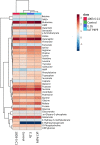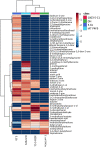Bacterial volatile organic compounds (VOCs) promote growth and induce metabolic changes in rice
- PMID: 36844905
- PMCID: PMC9948655
- DOI: 10.3389/fpls.2022.1056082
Bacterial volatile organic compounds (VOCs) promote growth and induce metabolic changes in rice
Abstract
Plant growth-promoting bacteria (PGPB) represent an eco-friendly alternative to reduce the use of chemical products while increasing the productivity of economically important crops. The emission of small gaseous signaling molecules from PGPB named volatile organic compounds (VOCs) has emerged as a promising biotechnological tool to promote biomass accumulation in model plants (especially Arabidopsis thaliana) and a few crops, such as tomato, lettuce, and cucumber. Rice (Oryza sativa) is the most essential food crop for more than half of the world's population. However, the use of VOCs to improve this crop performance has not yet been investigated. Here, we evaluated the composition and effects of bacterial VOCs on the growth and metabolism of rice. First, we selected bacterial isolates (IAT P4F9 and E.1b) that increased rice dry shoot biomass by up to 83% in co-cultivation assays performed with different durations of time (7 and 12 days). Metabolic profiles of the plants co-cultivated with these isolates and controls (without bacteria and non-promoter bacteria-1003-S-C1) were investigated via 1H nuclear magnetic resonance. The analysis identified metabolites (e.g., amino acids, sugars, and others) with differential abundance between treatments that might play a role in metabolic pathways, such as protein synthesis, signaling, photosynthesis, energy metabolism, and nitrogen assimilation, involved in rice growth promotion. Interestingly, VOCs from IAT P4F9 displayed a more consistent promotion activity and were also able to increase rice dry shoot biomass in vivo. Molecular identification by sequencing the 16S rRNA gene of the isolates IAT P4F9 and E.1b showed a higher identity with Serratia and Achromobacter species, respectively. Lastly, volatilomes of these and two other non-promoter bacteria (1003-S-C1 and Escherichia coli DH5α) were evaluated through headspace solid-phase microextraction coupled with gas chromatography-mass spectrometry. Compounds belonging to different chemical classes, such as benzenoids, ketones, alcohols, sulfide, alkanes, and pyrazines, were identified. One of these VOCs, nonan-2-one, was validated in vitro as a bioactive compound capable of promoting rice growth. Although further analyses are necessary to properly elucidate the molecular mechanisms, our results suggest that these two bacterial isolates are potential candidates as sources for bioproducts, contributing to a more sustainable agriculture.
Keywords: Oryza sativa; bioactive compounds; metabolomics; microbial volatile organic compounds; plant growth promotion.
Copyright © 2023 Almeida, de Araujo, Mulato, Persinoti, Sforça, Calderan-Rodrigues and Oliveira.
Conflict of interest statement
The authors declare that the research was conducted in the absence of any commercial or financial relationships that could be construed as a potential conflict of interest.
Figures



Similar articles
-
The power of the smallest: The inhibitory activity of microbial volatile organic compounds against phytopathogens.Front Microbiol. 2023 Jan 4;13:951130. doi: 10.3389/fmicb.2022.951130. eCollection 2022. Front Microbiol. 2023. PMID: 36687575 Free PMC article. Review.
-
Soil bacterial diffusible and volatile organic compounds inhibit Phytophthora capsici and promote plant growth.Sci Total Environ. 2019 Nov 20;692:267-280. doi: 10.1016/j.scitotenv.2019.07.061. Epub 2019 Jul 5. Sci Total Environ. 2019. PMID: 31349168
-
Antifungal Activity and Alleviation of Salt Stress by Volatile Organic Compounds of Native Pseudomonas Obtained from Mentha piperita.Plants (Basel). 2023 Mar 29;12(7):1488. doi: 10.3390/plants12071488. Plants (Basel). 2023. PMID: 37050113 Free PMC article.
-
Priming of Plant Growth Promotion by Volatiles of Root-Associated Microbacterium spp.Appl Environ Microbiol. 2018 Oct 30;84(22):e01865-18. doi: 10.1128/AEM.01865-18. Print 2018 Nov 15. Appl Environ Microbiol. 2018. PMID: 30194105 Free PMC article.
-
Exploitation of volatile organic compounds for rice field insect-pest management: current status and future prospects.Physiol Plant. 2025 May-Jun;177(3):e70240. doi: 10.1111/ppl.70240. Physiol Plant. 2025. PMID: 40317520 Review.
Cited by
-
Salt-tolerant plant growth-promoting bacteria as a versatile tool for combating salt stress in crop plants.Arch Microbiol. 2024 Jul 5;206(8):341. doi: 10.1007/s00203-024-04071-8. Arch Microbiol. 2024. PMID: 38967784 Review.
-
Impact of bacterial volatiles on the plant growth attributes and defense mechanism of rice seedling.Heliyon. 2024 Apr 14;10(8):e29692. doi: 10.1016/j.heliyon.2024.e29692. eCollection 2024 Apr 30. Heliyon. 2024. PMID: 38660266 Free PMC article.
-
Antifungal Activity of Phyllospheric Bacteria Isolated from Coffea arabica against Hemileia vastatrix.Microorganisms. 2024 Mar 14;12(3):582. doi: 10.3390/microorganisms12030582. Microorganisms. 2024. PMID: 38543633 Free PMC article.
-
Rhizosphere Microorganisms Supply Availability of Soil Nutrients and Induce Plant Defense.Microorganisms. 2024 Mar 11;12(3):558. doi: 10.3390/microorganisms12030558. Microorganisms. 2024. PMID: 38543610 Free PMC article. Review.
-
Immunity priming and biostimulation by airborne nonanal increase yield of field-grown common bean plants.Front Plant Sci. 2024 Nov 5;15:1451864. doi: 10.3389/fpls.2024.1451864. eCollection 2024. Front Plant Sci. 2024. PMID: 39568456 Free PMC article.
References
-
- Abadía J., López-Millán A. F., Rombolà A., Abadía A. (2002). Organic acids and fe deficiency: A review. Plant Soil 241 (1), 75–86. doi: 10.1023/A:1016093317898 - DOI
-
- Abdel-Rahman H. M., Salem A. A., Moustafa M. M. A., El-Garhy H. A. S. (2017). A novice Achromobacter sp. EMCC1936 strain acts as a plant-growth-promoting agent. Acta Physiol. Plant 39, 1–15. doi: 10.1007/s11738-017-2360-6 - DOI
-
- Agisha V. N., Kumar A., Eapen S. J., Sheoran N., Suseelabhai R. (2019). Broad-spectrum antimicrobial activity of volatile organic compounds from endophytic Pseudomonas putida BP25 against diverse plant pathogens. Biocontrol Sci. Technol. 29, 1069–1089. doi: 10.1080/09583157.2019.1657067 - DOI
LinkOut - more resources
Full Text Sources
Molecular Biology Databases

